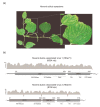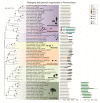Molecular Characterization of Hovenia Dulcis-Associated Virus 1 (HDaV1) and 2 (HDaV2): New Tentative Species within the Order Picornavirales
- PMID: 32867192
- PMCID: PMC7552035
- DOI: 10.3390/v12090950
Molecular Characterization of Hovenia Dulcis-Associated Virus 1 (HDaV1) and 2 (HDaV2): New Tentative Species within the Order Picornavirales
Abstract
In a systematic field survey for plant-infecting viruses, leaf tissues were collected from trees showing virus-like symptoms in Brazil. After viral enrichment, total RNA was extracted and sequenced using the MiSeq platform (Illumina). Two nearly full-length picorna-like genomes of 9534 and 8158 nucleotides were found associated with Hovenia dulcis (Rhamnaceae family). Based upon their genomic information, specific primers were synthetized and used in RT-PCR assays to identify plants hosting the viral sequences. The larger contig was tentatively named as Hovenia dulcis-associated virus 1 (HDaV1), and it exhibited low nucleotide and amino acid identities with Picornavirales species. The smaller contig was related to insect-associated members of the Dicistroviridae family but exhibited a distinct genome organization with three non-overlapping open reading frames (ORFs), and it was tentatively named as Hovenia dulcis-associated virus 2 (HDaV2). Phylogenetic analysis using the amino acid sequence of RNA-dependent RNA polymerase (RdRp) revealed that HDaV1 and HDaV2 clustered in distinct groups, and both viruses were tentatively assigned as new members of the order Picornavirales. HDaV2 was assigned as a novel species in the Dicistroviridae family. The 5' ends of both viruses are incomplete. In addition, a nucleotide composition analysis (NCA) revealed that HDaV1 and HDaV2 have similarities with invertebrate-infecting viruses, suggesting that the primary host(s) of these novel virus species remains to be discovered.
Keywords: HDaV1; HDaV2; Hovenia dulcis; Picornavirales; metagenomics; virome.
Conflict of interest statement
The authors declare no conflict of interest. The funders had no role in the design of the study; in the collection, analyses, or interpretation of data; in the writing of the manuscript, or in the decision to publish the results.
Figures



Similar articles
-
Genetic characterization of a novel picorna-like virus in Culex spp. mosquitoes from Mozambique.Virol J. 2018 Apr 18;15(1):71. doi: 10.1186/s12985-018-0981-z. Virol J. 2018. PMID: 29669586 Free PMC article.
-
Isolation and characterization of a novel cripavirus, the first Dicistroviridae family member infecting the cotton mealybug Phenacoccus solenopsis.Arch Virol. 2020 Sep;165(9):1987-1994. doi: 10.1007/s00705-020-04702-7. Epub 2020 Jun 25. Arch Virol. 2020. PMID: 32588240
-
Aphis glycines virus 1, a new bicistronic virus with two functional internal ribosome entry sites, is related to a group of unclassified viruses in the Picornavirales.J Gen Virol. 2020 Jan;101(1):105-111. doi: 10.1099/jgv.0.001355. J Gen Virol. 2020. PMID: 31769392
-
Torradoviruses.Annu Rev Phytopathol. 2015;53:485-512. doi: 10.1146/annurev-phyto-080614-120021. Epub 2015 Jun 5. Annu Rev Phytopathol. 2015. PMID: 26047567 Review.
-
Invertebrate RNA virus diversity from a taxonomic point of view.J Invertebr Pathol. 2017 Jul;147:37-50. doi: 10.1016/j.jip.2016.10.002. Epub 2016 Oct 25. J Invertebr Pathol. 2017. PMID: 27793741 Free PMC article. Review.
Cited by
-
Novel plant-associated genomoviruses from the Brazilian Cerrado biome.Arch Virol. 2023 Nov 9;168(12):286. doi: 10.1007/s00705-023-05892-6. Arch Virol. 2023. PMID: 37940763
-
Geminiviridae and Alphasatellitidae Diversity Revealed by Metagenomic Analysis of Susceptible and Tolerant Tomato Cultivars across Distinct Brazilian Biomes.Viruses. 2024 Jun 1;16(6):899. doi: 10.3390/v16060899. Viruses. 2024. PMID: 38932191 Free PMC article.
-
Characterization of a Novel RNA Virus Causing Massive Mortality in Yellow Catfish, Pelteobagrus fulvidraco, as an Emerging Genus in Caliciviridae (Picornavirales).Microbiol Spectr. 2022 Aug 31;10(4):e0062422. doi: 10.1128/spectrum.00624-22. Epub 2022 Aug 4. Microbiol Spectr. 2022. PMID: 35924844 Free PMC article.
-
In-depth analysis of 17,115 rice transcriptomes reveals extensive viral diversity in rice plants.Nat Commun. 2025 Feb 12;16(1):1559. doi: 10.1038/s41467-025-56769-y. Nat Commun. 2025. PMID: 39939599 Free PMC article.
References
-
- Keenan R.J., Reams G.A., Achard F., de Freitas J.V., Grainger A., Lindquist E. Dynamics of global forest area: Results from the FAO Global Forest Resources Assessment 2015. For. Ecol. Manag. 2015;352:9–20. doi: 10.1016/j.foreco.2015.06.014. - DOI
-
- Bełka M., Gonthier P., Nicolotti G. In: 2013: Infectious Forest Diseases. Gonthier P., Nicolotti G., editors. CABI; Wallingford, UK: Boston, MA, USA: 2015. p. 641.
-
- Nienhaus F., Castello J.D. Viruses in forest trees. Annu. Rev. Phytopathol. 1989;27:165–186. doi: 10.1146/annurev.py.27.090189.001121. - DOI
-
- Büttner C., Von Bargen S., Bandte M., Mühlbach H.-P. Infectious Forest Diseases. CABI; Wallingford, UK: 2013. Forest diseases caused by viruses; pp. 50–75.
-
- Lin M.T., Kitajima E.W., Costa C.L. Association of cassia mild mosaic virus with dieback of Cassia macranthera in central Brazil. Plant Dis. 1980;64:587–589. doi: 10.1094/PD-64-587. - DOI
Publication types
MeSH terms
Substances
LinkOut - more resources
Full Text Sources
Research Materials

